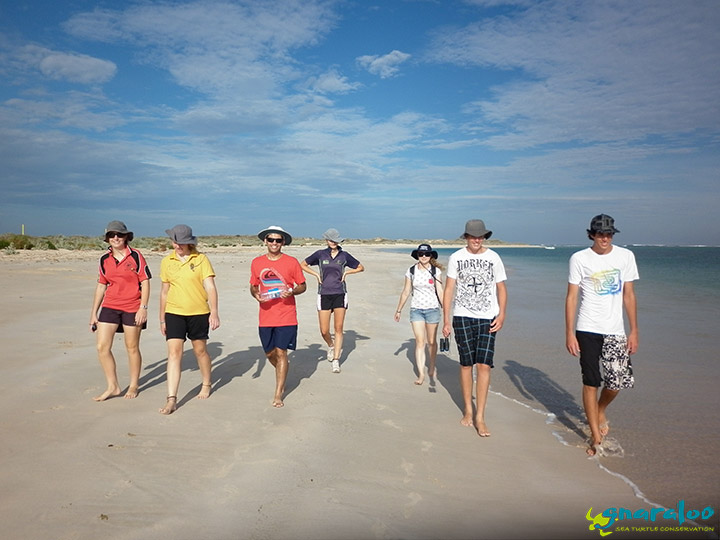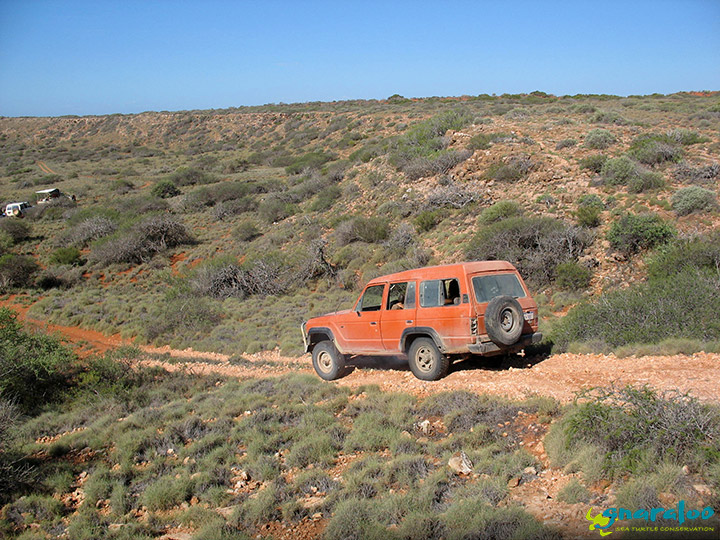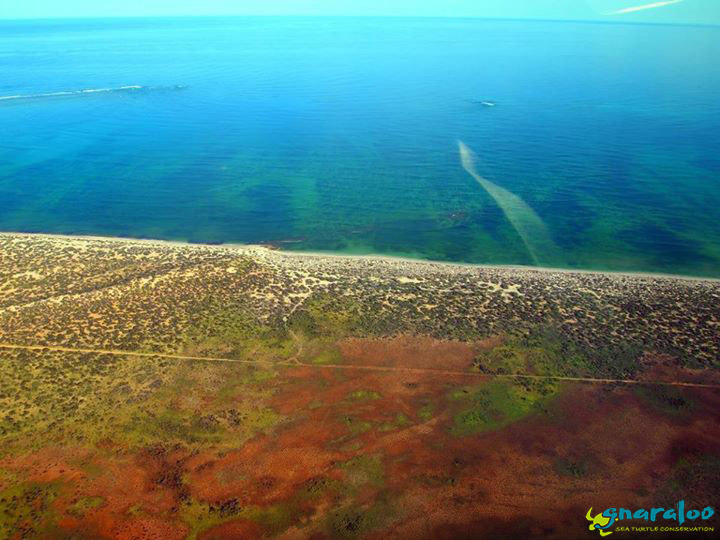Hello all GTCP friends! As noted on the Gnaraloo Bay Turtle Thermometer, the GTCP monitoring…

Nagle Catholic College visits us
The Gnaraloo Turtle Conservation Program opened up a new chapter in its community engagement program. On 23 January 2012, 11 students and 3 teachers from Nagle Catholic College in Geraldton, Western Australia, travelled the long road to Gnaraloo Station (7hrs!) to participate with the GTCP for a week. This was very special for us because it was the first school group to visit and participation onsite in morning track patrols by the GTCP researchers. Whilst Nagle intended to come up last year during the season 2010/11, their trip was derailed by the cyclones that hit Carnarvon. We were very excited to finally have a school group visit Gnaraloo and participate with our ‘science in action’ turtle monitoring work.
The Nagle group, whose students were from a Year 12 Biology class, arrived at the Gnaraloo Homestead around 3:30pm on the Monday afternoon. They were shown their accommodations which were located at the Homestead’s Fishing Lodge, a backpacker/ dorm style accommodation. After the students had settled in to their rooms, we gathered them together to give a presentation about Gnaraloo and research under the GTCP. This presentation gave us the opportunity to introduce the students to Gnaraloo and the unique and pristine environment that surrounded them. We also briefed them on what kind of research was conducted during the morning turtle monitoring surveys and what they themselves would be helping us with. It was also a great time for us to meet the students and teachers who would be our research partners for the next few days. Unfortunately, their visit coincided with the start of an unusual string of rainy days that drenched Gnaraloo and the presentation had to be given in the kitchen of the Fishing Lodge! Despite the rainy conditions, all of the students seemed very eager to be at Gnaraloo and they were amazed at the view that they had just outside their rooms. After the presentation, we encouraged the students to have a nice dinner together, but then to get some sleep to prepare them for the 5:00am wake up call the next morning!
The next morning, the students (some more awake than others) followed us out to the Gnaraloo Bay Rookery, to Beach Point 7 (BP7), the beginning point of our morning patrols. Once at BP7, we split the group into groups of 7: one group to follow the GTCP researcher patrolling north to Beach Point 9 (BP9) and the other group to follow the other GTCP researcher patrolling south to Gnaraloo Bay North (GBN). During the beginning of the monitoring patrols, we discussed the three main objectives of our patrol with the students: (1) locate new turtle tracks and nests; (2) check all of our sampled staked nests for predator and environmental damage; and (3) record any animal tracks that were present on the beach. We also educated the group about the life cycle of sea turtles and the nesting process of females and fielded any questions that they had for us. Once we reached the first turtle track, we instructed the students on how to tell what species of sea turtle made the track, which direction she was going, and whether she nested or not. After observing and learning the identification processes on the first few tracks, we handed the students the clipboards with the GTCP data sheets and the GPS instruments. Under our supervision, we then left the data collection up to the students to decipher the next few turtle tracks with no help from us. Impressively, the students were able to record all of the data correctly for most of the tracks. What was most difficult for them (as is for us as well) was telling if the turtle nested or not (i.e. identification of a nest vs. an unsuccessful nesting attempt) just by looking at the marks the turtle made and that was left in the sand after subsequent winds and tides swept over it.
The Nagle group patrolled with us for 3 mornings and it seemed that the two groups of 7 each were in somewhat of a competition with each other on who saw the coolest thing on the beach, whether it was a turtle egg, a dead hatchling being carried away by a crab, or a crab species that we have yet to identify! Over the course of the 3 days, the students had a great time patrolling the beach whilst also learning about sea turtle breeding and nesting behaviour.
After the GTCP patrols each day, the Nagle students and teachers were left to themselves to explore what Gnaraloo has to offer. Obviously the most popular afternoon activities were snorkelling in the beautiful waters of Gnaraloo Bay and 3Mile Lagoon. However, that week was a particularly crazy week for weather at Gnaraloo. In addition to the unusual amount of rain, on the group’s third day here, the large Gascoyne fires that had been burning since late December 2011 broke out on the neighbouring property to the south, Quobba Station, due to a lightning strike from one of the rain storms we received. Although the Gnaraloo Homestead area where everyone was staying was never in danger, it was a little unnerving for us to know that under the correct wind conditions, the fire could easily spread to Gnaraloo. In addition to this, Cyclone Iggy had just formed off the north west coast of Western Australia. At the time, the projected path showed the cyclone reaching a Category 3 status and hitting very near the Gnaraloo coastline. With these issues, combined with the warning by the Gnaraloo leaseholder, Paul Richardson, that the Gnaraloo access roads may be closed the following day for safety reasons, the Nagle group decided not to take their chances of getting stuck at Gnaraloo and headed out early on Thursday night, 26 January 2012. It was unfortunate that they had to take off, but we were very glad that they were able to come up for the time they could.
We hope that the Nagle students had as much fun participating with the GTCP and being at Gnaraloo as we did hosting them. It is really rewarding to be able to spread the information about our program to the West Australian public whose backyard we’re working in. We believe it is very important to share this knowledge of the environment and to encourage everyone to become involved. The trip by the students and teachers from Nagle Catholic College is just the beginning of what we hope to be a very successful component of the GTCP. We hope very much that these onsite visits by school groups become a regular part of the community engagement program during the turtle nesting season at Gnaraloo every year. This first school visit is a great accomplishment for our ever-growing program of scientific engagement with the community.
We thank Nagle Catholic College who exhibited the utmost respect for not only us, but the environment at Gnaraloo as well. We hope you learned a good deal about sea turtles and the special biodiversity we have here at Gnaraloo. We would also like to thank the teachers, Mr. Mike Francis and Mr. Arran Jodah, who organized the trip on behalf of Nagle and made it possible for us to share our knowledge about sea turtles with them and their students.
We hope to see you guys back here next year!
Cheers, Bobby





